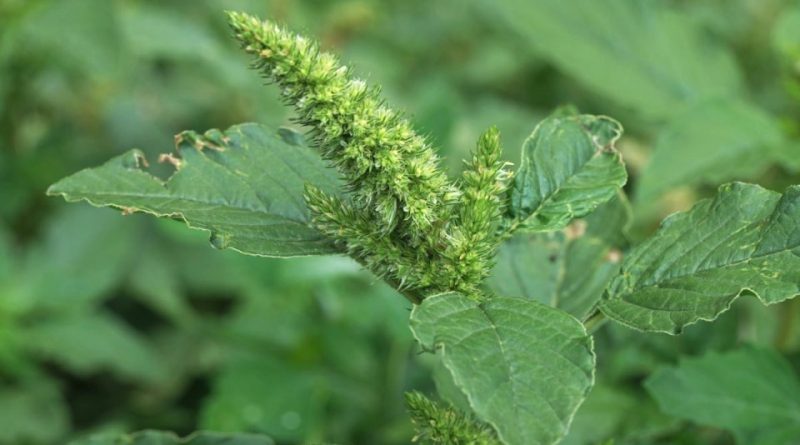Amaranthus retroflexus
Amaranthus retroflexus
The common Amaranth (Amaranthus retroflexus L.) is an herbaceous species belonging to the Amaranthaceae family.
Systematics –
From the systematic point of view it belongs to the Domain Eukaryota, Kingdom Plantae, Subarignus Tracheobionta, Division Magnoliophyta, Class Rosopsida, Subclass Caryophyllidae, Order Caryophyllales, Family Amaranthaceae and then to the Genus Amaranthus and to the A. Species retroflexus.
The terimini are synonymous: Amaranthus spicatus Lam., Nom. illeg., Amaranthus delilei Loret, Amaranthus strictus Ten ..
Etymology –
The term Amaranthus comes from the Greek, α-alfa privativo and μαραίνω maráino I wither: that is of a plant that does not wither. The specific retroflexus epithet derives from the prefix back-back and from bending fold: folded backwards.
Geographic Distribution and Habitat –
The common Amaranth is a species of North American origin and today widespread throughout the planet. Its habitat is the fields, gravel places, uncultivated, ruins, rubble and along the riverbed of the rivers from 0 to 900 m asl ..
Description –
Amaranthus retroflexus is an annual mono-herbaceous species that can grow at heights ranging from 20 to 100 cm and can reach up to 300 cm in its natural habitat. It presents an erect stem, woody in the lower part, light green and reddish at the base, simple or ramose and pubescent in the distal part formed by a thick and thick inflorescence. Even the branches and stems are reddish at the base. The leaves are long-petiolate (1.5 – 5.5 cm) with full lamina, rhomboid or elliptic ovate with acute, obtuse or flat apex, slightly wavy margin with marked bottom ribs and pubescent 2-10 (15) x 1 -5 (7) cm. It has a compact panicle inflorescence with a terminal spike more or less similar to the lateral ones with retroflexed or erect top, green or sometimes silvery or reddish or yellowish. It presents tepals spatulate-obovate or lanceolate-spatulate with truncated or dislocated apex and equal to the stigmas (2) 2,5 – 3,5 (4) mm. The bracts of the female flowers are lanceolate or subulate, with a rigid and pungent terminal mucrone and tepals ((2.5) 3.5 – 5 (6) mm.) The flowers are unisexual, pentamers with white petals. and longer than the perianth, the stigmas are 3 or rarely 2. The fruit is an ellipsoidal pisside as the perianth and horizontally deiscent.It produces seeds of dark brown or reddish color, lenticular in shape with a rough and shiny surface (1) 1, 1 – 1.3 (1.4) mm of diameter The antesis is in the period between June and October.
Cultivation –
For the cultivation of amaranth, remember that it reproduces only by seed, and a single plant can produce up to a million, even if the average is one hundred thousand. Germination is stimulated by light and humidity, which is why the seed must be on the surface. The emergency period is spring, around the beginning of June. In addition to the cultivated fields, the amaranth grows in the meadows and on the edges of the paths, from the plain up to the high hill. The plants are alive throughout the autumn period. One piece of advice we give for harvesting is to avoid polluted areas or where pesticides have been used for agriculture and nitrogen as these will be concentrated in the plant.
Uses and Traditions –
The amaranth plant was already known and appreciated by Native Americans. The Cherokee used the common amaranth as a religious ceremonial herb, as an astringent for a too abundant female cycle and gynecological medicine; the Keres recognized the healing properties of the gastrointestinal tract; the Mohegan made it an infusion for a sore throat. The Navajo made bread and cakes.
Research has shown that Amaranthus retroflexus is able to store the cesium-137 radioactive isotope.
The common amaranth is a robust and resistant plant and is also very common in the vegetable gardens, often together with the common farinello or common farinaccio (Chenopodium album). For the vit. Content A and C and calcium and iron salts are recognized astringent properties and to revitalize particularly defiled individuals.
Preparation Mode –
Amaranthus retroflexus, like all amarants, rosette leaves are edible to make boiled soups along with other herbs. It tastes similar to spinach. The still tender stem, before the inflorescence appears, can be used as asparagus. The shredded seeds can be used as the flour of cereals or mixed together enriching it with protein.
Amaranth flour is ideal for those suffering from celiac disease or want to eliminate gluten. It is in fact a gluten-free flour, rather tasty (ideal for cakes, bread, biscuits and all the other products you can prepare at home).
For any purpose, the boiling water of the common amaranth should never be used because this plant is also able to synthesise the nitrates so the cooking water is polluted by these; for this reason those plants that grow far from cultivated fields where nitric fertilization is used should be collected. Usually the amaranth is cooked in simple salads, seasoned with extra-virgin olive oil and lemon. It is also often used in soups and soups.
Guido Bissanti
Sources
– Acta Plantarum – Flora of the Italian Regions.
– Wikipedia, the free encyclopedia.
– Treben M., 2000. Health from the Pharmacy of the Lord, Advice and experience with medicinal herbs, Ennsthaler Publisher
– Pignatti S., 1982. Flora of Italy, Edagricole, Bologna.
– Conti F., Abbate G., Alessandrini A., Blasi C. (edited by), 2005. An annotated checklist of the Italian vascular flora, Palombi Editore.
Attention: Pharmaceutical applications and alimurgical uses are indicated for informational purposes only, they do not in any way represent a medical prescription; we therefore decline any responsibility for their use for curative, aesthetic or alimentary purposes.


